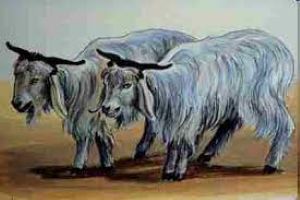On Yom Kippur, when the High Priest entered the Most Holy Place, he performed separate offerings for his own sins and those of the Israelite community (Leviticus 16). He first offered a bull for himself and his household. Using his finger, he sprinkled the bull’s blood on the front of the atonement cover and then sprinkled it seven times before the atonement cover.
Next, he selected two goats: one for the Lord and one as the scapegoat. The goat chosen by lot for the Lord was sacrificed as a sin offering. The High Priest then re-entered the Most Holy Place with the goat’s blood and sprinkled it in the same manner as the bull’s blood. This blood atoned for the sins of the Israelite community.
The High Priest then placed both hands on the head of the live goat, known as the scapegoat, and confessed over it all the sins, rebellion, and wickedness of the Israelites. The goat, bearing these sins, was sent away and released into a remote place in the wilderness.
An interesting question is how the term “scapegoat” became part of modern English vernacular. Historically, our culture was rooted in a Judeo-Christian worldview, where Bible stories were widely known and discussed. A single unique word from a biblical story, such as “shibboleth,” could instantly evoke the associated narrative. Thus, it is easy to see how the Yom Kippur scapegoat story became a commonly used idiom. However, as our culture has shifted, biblical stories are less familiar, often replaced by Disney narratives and Hollywood tales.
The scapegoat story also includes Jewish traditions from the Second Temple period, not prescribed in Scripture but documented in historical literature. The High Priest would tie a scarlet thread to the horns of the scapegoat and another to the outside of the Temple door. According to tradition, the thread would miraculously turn white, signaling to the people that their sins were forgiven.
The Talmud, a primary source of Rabbinic Judaism, records commentary on the Scriptures. It notes that during the 40 years before the Temple’s destruction in 70 AD, the scarlet thread never turned white. Notably, approximately 40 years before this destruction, at the time of Jesus’ crucifixion, the veil separating the Holy Place from the Most Holy Place was miraculously torn from top to bottom. This event symbolized that Jesus’ eternal sacrifice had opened the way to God’s presence, superseding the annual Yom Kippur sacrifices.
Remarkably, God not only fulfills Scripture but sometimes also affirms extra-biblical Jewish traditions. The scarlet thread’s failure to turn white after Jesus’ sacrifice may be an example of this, signaling the completion of His eternal atonement.
Some also connect this to the biblical story of Rahab, who was saved during Jericho’s destruction by tying a scarlet thread in her window—a symbol of salvation.
© 2025 B Arnold Stein

Leave a Reply